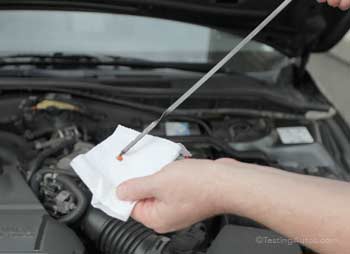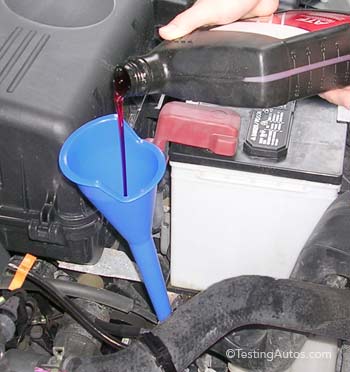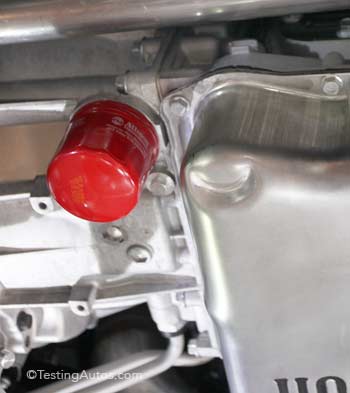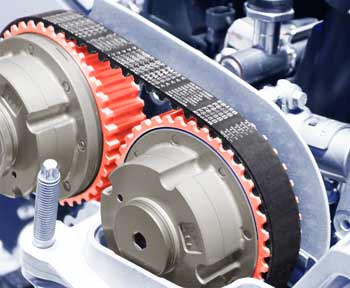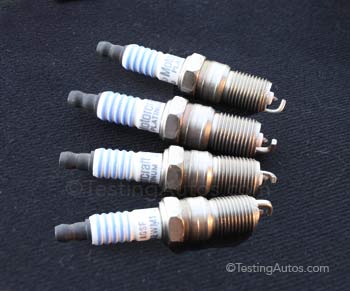When you should or shouldn't change your automatic transmission fluid
This question was easy to answer before: Your mechanic pulls the transmission dipstick out and drops some fluid on a piece of paper. Does it look brownish or smell burnt? Do you see any dirt on the paper? If yes, you know it's time to change it.Recommended transmission fluid change intervals varied between 30,000 and 50,000 miles. One of the main reasons for transmission failures is overheating. This means, if you tow a trailer or drive in a mountainous area, change the fluid more often.
Today, many cars don't have a transmission dipstick. How do you know if the transmission fluid needs changing? A quick look into the maintenance schedule may help.
For example, for the 2017 Jeep Wrangler, the maintenance schedule says: change transmission fluid at 60,000 miles if using your vehicle for any of the following: police, taxi, fleet, or frequent trailer towing, otherwise, change at 120,000 miles. Knowing this, you can decide when to change your transmission fluid based on the severity of the load, but you know it needs to be changed between 60,000 and 120,000 miles.
For example, the Warranty and Maintenance Guide for the 2018 Toyota Camry says to change the transmission fluid at 60,000 miles when "Driving while towing, using a car-top carrier, or heavy vehicle loading" as well as when "Extensive idling and/or low speed driving for a long distance such as police, taxi or door-to-door delivery use." It's called Special Operating Conditions. For normal driving conditions, the transmission fluid change is not included.
If the transmission fluid change is not in the maintenance schedule, does it mean it's filled for life? We know that we have to take manufacturer's recommendations with a grain of salt. They want to show lower maintenance costs. Yes, fluid quality and transmission technology have improved, but no, this did not eliminate mechanical wear.
Transmission problems, whether caused by wear and tear or other reasons, are still common in many cars. The fact that auto manufacturers are striving to reduce the size and weight (and cost!) of their transmissions doesn't help either. Transmission rebuilding shops aren't going out of business anytime soon.
Should you change the transmission fluid if it's not mentioned in the maintenance schedule? Is there any reason not to change transmission fluid at all? We spoke with two car owners with different views:
Joe: I drive a lot and I want to know for sure that my transmission is in good shape. I checked my maintenance schedule and it doesn't even mention transmission fluid. I visited my dealer where I bought the car and asked the technician that I know, who worked on my car before. He said there was no problem and he got it done for me. It was at 55K miles, now I'm at 80K and my car runs fine.
Ed: My truck has over 160K miles. I bought it used, a year ago. Sometimes when I shift into reverse, there is a little delay before the tranny engages, but otherwise it drives fine. My mechanic told me that the fluid is very dirty, but he warned me that changing transmission fluid at high mileage when it's that dirty is risky and sometimes can make it worse, so I decided to leave it.
Both opinions make sense. If you want to keep your car longer, you want to make sure it's in good shape. You can ask your dealer's opinion on changing transmission fluid. If they do recommend it, you know they can do it right and will use the correct fluid. The price for changing transmission fluid ranges from $150 to $350. Reputable car dealers are also more likely to stand behind their services than small quick-lube shops if something goes wrong.
Why is it risky to change transmission fluid in high-mileage cars? If the fluid has never been changed, it might be contaminated by products of wear. In a worn-out transmission, these products of wear can temporarily "seal" various pistons and O-rings. Once all the dirt is flushed out, the transmission may start slipping or shifting differently. Cases like this are rare, but we have seen this happening.
For the same reason, if a transmission already shifts rough, slips or has other problems, changing the fluid is unlikely to fix these problems.
Is drain and refill safer than a flush with a machine? Flushing the transmission using a machine was common when the transmission fluid was more or less universal. Now, every manufacturer has their own specific fluid that cannot be mixed with anything else. Because repair shops usually have only one flush machine, they may use it for different cars.
For this reason, it's safer to do a drain and refill service. The flush machine does change more fluid at once, though. If you do drain and refill, you only can drain about 30-45% of the fluid.
How do mechanics check the fluid level and condition without a regular dipstick? Some transmissions have an oil filler plug (overflow plug or inspection plug), some have a small bolted-in dipstick.
Advertisement
Does that mean you cannot change the transmission fluid in a small garage or as a DIY project? No, if you watch DIY videos on Youtube, some people simply measure the amount of the fluid drained and add exactly the same amount.
Regardless of where you want to change your transmission fluid, we strongly advise to use only the proper fluid type. You can buy it from your local dealer.
Do you need to change the filter when changing transmission fluid? Most cars have a fine-mesh screen that doesn't need to be replaced. There are cars that do have a transmission fluid filter that needs to be changed. The one in the photo, for example, is a spin-on transmission fluid filter on the Allison transmission of the GMC Sierra HD.
You can find out whether your car has a filter in an owners manual or maintenance schedule. For example, the manual for the 2018 Ford F150 says "Change automatic transmission fluid and filter at 150K." Volkswagen recommends changing the fluid and filter in the DSG transmission (automated-manual) every 40,000 miles (for 2012 models).
In some cars, a transmission fluid filter is mounted on the outside of the transmission, in others, the transmission pan will have to be removed to replace the filter. Does the magnet inside the transmission pan need to be cleaned when changing the transmission fluid? The magnet needs to be cleaned whenever the transmission pan is removed. If the fluid can be changed without removing the pan, then cleaning the magnet is not necessary.
